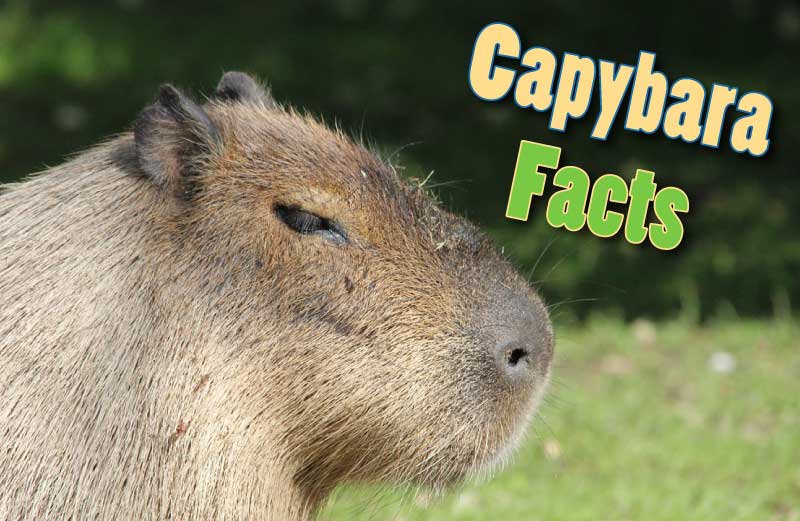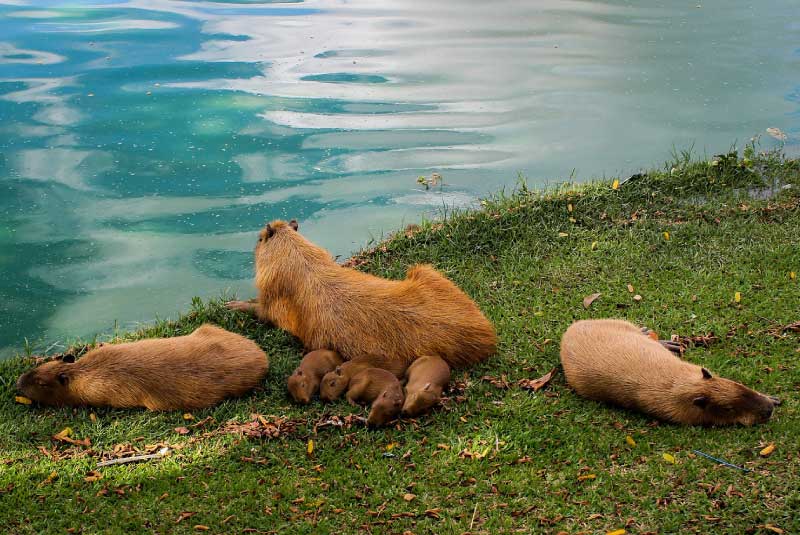Capybaras are the world’s largest rodents. They are semi-aquatic, and spend much of their time in or around water. Let’s learn some amazing capybara facts …
(Part of our rainforest animals series.)
You can watch the video below to see capybaras in the wild. There is also a list of quick facts at the end of the article.
What Does A Capybara Look Like?
Capybaras look a little like overgrown guinea pigs, which is no surprise: the animals are closely related.
Capybaras have big, barrel-shaped bodies with rather square heads. Their long, thick hair is varying shades of golden or reddish-brown.
The capybara’s eyes, nose and mouth are located near the top of its head. This allows it to see and breathe while the rest of its body is under water.
Capybaras have other adaptations for a semi-aquatic life. While diving, capybaras can press their ears flat against their heads to prevent water getting in. They can stay underwater for up to five minutes.
Capybaras also have slightly webbed feet with big claws. This helps them not only to swim but also to walk on the slippery rainforest floor.
The capybara’s fur helps to retain heat and dries quickly after it leaves the water.
How Big Are Capybaras?
Capybaras are the world’s largest rodents. When they are fully grown capybaras weigh between 35 and 65 kilograms (77 and 143 lb) and stand up to 62 cm (2 ft.) tall, with a total body length of up to 1.34 m (4.5 ft.).
What Animals Are Capybaras Related To?
Rodents are mammals in the order Rodentia (an order is a big group of animals). The main characteristic shared by all rodents is a pair of sharp front teeth that grow continuously throughout the animal’s lifetime.
Around 40% of all mammals are rodents. Other well-known rodents include rats, hampsters, mice, and squirrels.
The scientific name for a capybara is Hydrochoerus hydrochaeris.
Members Of The Cavy Family
The capybara is closely related to the guinea pig. Both species are members of the cavy family, Caviidae.
Capybaras are also known as ‘water cavies’.
Capybara Video
Capybara Facts: Where do capybaras live?
Capybaras are found in every country in South America apart from Chile. They are also found in Central America, and have even been spotted in Florida!
Capybara Habitat
Capybaras are always found near water. They live in swampy, marshy grassland areas, and woods and forests next to rivers and lakes.
The Native American Guarani Indians call capybaras “master of the grasses” because they like living in lush, green spaces.
Rainforests are perfect for capybaras because they provide an ideal habitat of long grass and water.
The capybara’s watery habitat provides safety from predators. When capybaras sense a threat they dive into the water. The capybaras’ pale brown fur provides camouflage in the murky water.
What Do Capybaras Eat?
Capybaras are herbivores, which mean they only eat plants. They eat water plants and grasses, and have been known to graze with cattle!
Another thing that capybaras like to eat is their own poop! Although it sounds gross, it actually helps them to get more protein and nutrients from their food.
Capybara Predators
Capybaras have a number of rainforest predators. These include: jaguars, pumas, ocelots, harpy eagles and green anacondas.
Quick Capybara Facts For Kids
- The capybara’s scientific name is Hydrochoerus hydrochaeris.
- Capybaras are the world’s biggest rodent.
- Capybaras live in groups of 10-20 and are very social.
- Capybaras are found in every South American country apart from Chile.
- In the wild, capybaras live for around 8-10 years.
- Capybaras communicate with whimpering, clicking, purring and barking noises.
- The capybara’s sharp incisors (front teeth) never stop growing.
- Capybaras weigh up to 3.5 kilograms.
- Capybaras are semi-aquatic and spend most of their lives in or near to water.
- Guarani Indians call capybaras “master of the grasses”.
Discover More with Active Wild
You can discover more rainforest animals on this page: Rainforest Animals List with Pictures & Facts






